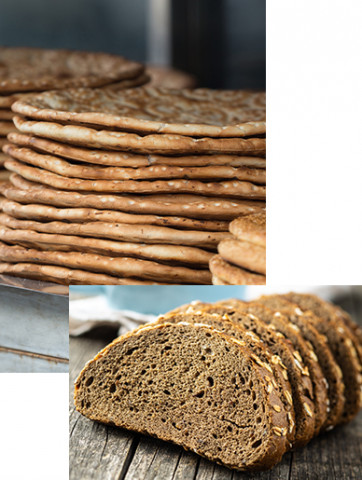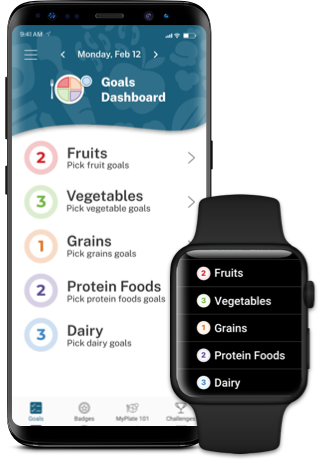Grains
Make half your grains whole grains.
What foods are in the Grains Group?
Foods made from wheat, rice, oats, cornmeal, barley, or another cereal grain is a grain product. Bread, pasta, breakfast cereals, grits, and tortillas are examples of grain products. Foods such as popcorn, rice, and oatmeal are also included in the Grains Group.
Grains have two subgroups: whole grains and refined grains.
Whole grains have the entire grain kernel, which includes the bran, germ, and endosperm. Some whole-grain examples are whole-wheat flour, bulgur (cracked wheat), oatmeal, and brown rice.
Refined grains have been milled, a process that removes the bran and germ. This is done to give grains a finer texture and improve their shelf life. But it also removes dietary fiber, iron, and many B vitamins. Some examples of refined grain products are white flour, corn grits, white bread, and white rice.
Refined grains should be enriched. This means adding back certain B vitamins (thiamin, riboflavin, niacin, folic acid) and iron. However, fiber is not added back to enriched grains. Check the ingredient list on refined grain products. The word "enriched" should appear in the grain name.
Some food products are made from mixtures of whole grains and refined grains. Only foods that are made with 100% whole grains are considered a whole grain food.
More About the Grains Group
Note: Click on the top row to expand the table. If you are on a mobile device, you may need to turn your phone to see the full table.
*These are general recommendations by age. Find the right amount for you by getting your MyPlate Plan.
| Daily Recommendations* | |||
|---|---|---|---|
| Total Grains in ounce-equivalents |
Whole Grains in ounce-equivalents | ||
| Toddlers | 12 to 23 months | 1¾ to 3 oz-equiv | 1½ to 2 oz-equiv |
| Children | 2-3 yrs 4-8 yrs |
3 to 5 oz-equiv 4 to 6 oz-equiv |
1½ to 3 oz-equiv 2 to 3 oz-equiv |
| Girls | 9-13 yrs 14-18 yrs |
5 to 7 oz-equiv 6 to 8 oz-equiv |
2½ to 3½ oz-equiv 3 to 4 oz-equiv |
| Boys | 9-13 yrs 14-18 yrs |
5 to 9 oz-equiv 6 to 10 oz-equiv |
3 to 4½ oz-equiv 3 to 5 oz-equiv |
| Women | 19-30 yrs 31-59 yrs 60+ yrs |
6 to 8 oz-equiv 5 to 7 oz-equiv 5 to 7 oz-equiv |
3 to 4 oz-equiv 3 to 3½ oz-equiv 3 to 3½ oz-equiv |
| Men | 19-30 yrs 31-59 yrs 60+ yrs |
8 to 10 oz-equiv 7 to 10 oz-equiv 6 to 9 oz-equiv |
4 to 5 oz-equiv 3½ to 5 oz-equiv 3 to 4½ oz-equiv |
|
OUNCE EQUIVALENT OF GRAINS |
|
|---|---|
| Amount that counts as 1 ounce-equivalent (oz-equiv) of grains | |
| Bagels | 2" mini bagel |
| Bagel or pita chips | ⅓ cup bagel or pita chips |
| Barley | ½ cup, cooked |
| Buckwheat | ½ cup, cooked |
| Biscuits | 1 small biscuit |
| Breads |
1 regular slice of bread 1 small slice of French bread 4 snack-size slices of rye bread |
| Bulgur | ½ cup, cooked |
| Challah bread |
1 medium or regular slice |
| Chapati |
1 small chapati or roti (6") ½ large chapati or roti (8") |
| Cornbread | 1 small piece of cornbread |
| Couscous | ½ cup, cooked |
| Crackers |
5 whole wheat crackers 2 rye crisp breads 7 square or round crackers |
| English muffins | ½ English muffin |
| Muffins | 1 small muffin |
| Oatmeal |
½ cup, cooked 1 packet instant 1 ounce (⅓ cup), dry (regular or quick) |
| Pancakes |
1 pancake (4½" diameter) 2 small pancakes (3" diameter) |
| Pasta -- spaghetti, macaroni, noodles |
½ cup, cooked 1 ounce, dry |
| Popcorn | 3 cups, popped |
| Quinoa | ½ cup, cooked |
| Ready-to-eat breakfast cereal |
1 cup, flakes or rounds 1¼ cup, puffed |
| Rice |
½ cup, cooked 1 ounce, dry |
| Tortillas |
1 small flour tortilla (6" diameter) 1 corn tortilla (6" diameter) |
Why is it important to eat grains, especially whole grains?
Eating grains, especially whole grains, provides health benefits. People who eat grains regularly may have a reduced risk of some diseases. Grains provide many nutrients that are vital for the health and maintenance of our bodies.

Health Benefits
All food and beverage choices matter. Focus on variety, amount, and nutrition.
- Eating whole grains as part of a healthy diet may reduce the risk of getting heart disease.
- Eating whole grain foods that have fiber, as part of an overall healthy diet, can support healthy digestion.
- Eating whole grains, as part of an overall healthy diet, may help with weight management.
- Eating grain products with folate before and during pregnancy as part of an overall healthy diet helps prevent neural tube defects. Neural tube defects are birth defects of the brain, spine, or spinal cord.
Food Group Gallery
Do you want to know more about the foods in the Grains Group? What does an ounce-equivalent of grains look like? Check out the Food Group Gallery! This is a great resource if you're trying to eat more whole grains. It will also help you add more variety to your meals.
Muesli, quinoa, wild rice... they're all waiting for you in the Food Group Gallery.





